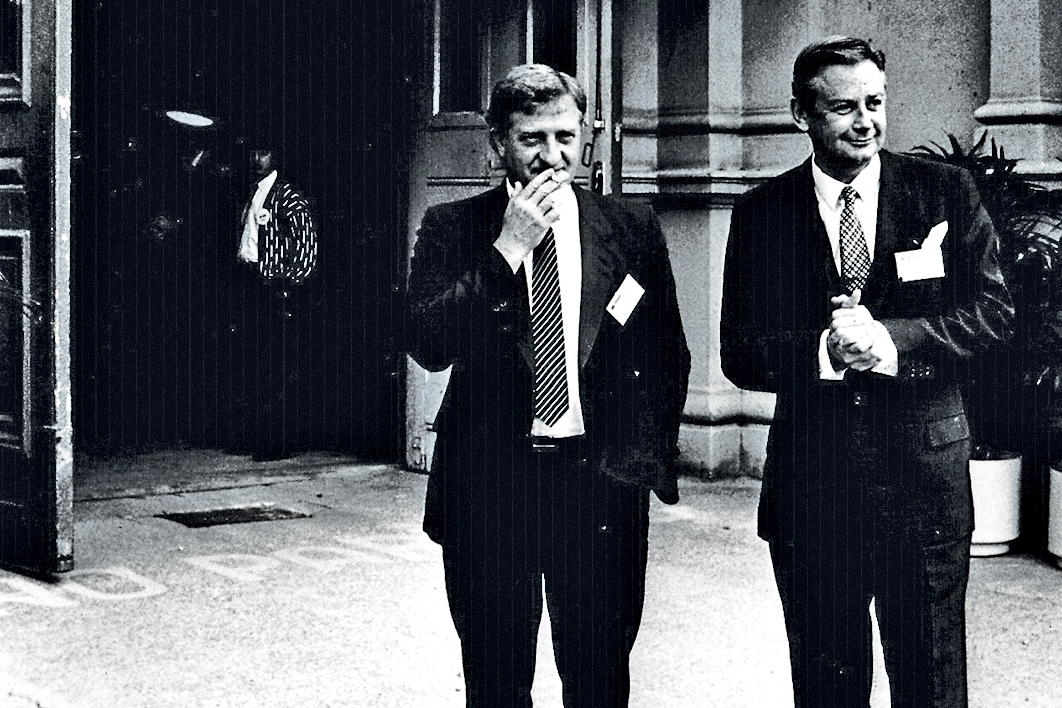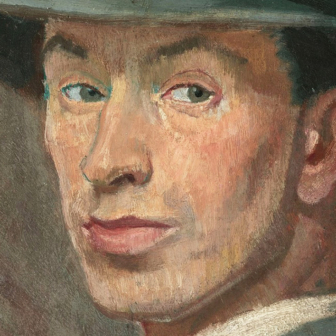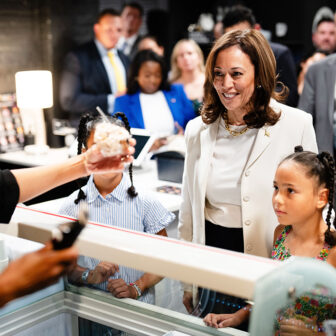When the BRW Rich List announced in 1987 that Australia now had it first two billionaires, their names — the cashed-up media magnate Kerry Packer and the lawyer and corporate raider Robert Holmes à Court — came as no surprise. The “patrician and the punter,” journalist Les Carlyon dubbed them: “it was the age of the entrepreneur, just as surely as 1847 was the age of the squatter.” “Only the 1851 gold rush could rival 1987,” added BRW business editor Robert Gottliebsen, grasping for another historical parallel.
But neither of the comparisons quite worked. Company mergers and acquisitions alone accounted for a massive $11 billion-plus in 1987; Australia had never seen anything like it. Yet while he recognised that “eventually the stock market will take a tumble,” Gottliebsen was optimistic: not only had unprecedented wealth been created but also the foundations of even greater wealth were being laid.
That the entrepreneurs’ castles were built of sand seemed to elude even the most experienced business journalists. As during every previous boom, there was something deeply alluring in the idea that this one was different. A recognition that “many of the new men were essentially traders, buying other people’s assets rather than creating new ones” was leavened, they believed, by the “aggregations of substance” they had supposedly assembled.
Of all the corporate battles of the 1980s, the greatest was between John Elliott and Robert Holmes à Court. It would be hard to conjure up two men less alike, but both wanted control of BHP, Australia’s largest company.
The chain-smoking, football-loving Elliott’s public persona was that of the rugged Aussie bloke without polish or pretension, one with the tastes and manner of an ordinary working man. “In an era when males are tending to become effeminate, he is the opposite end of the graph,” wrote journalist Keith Dunstan in 1985. A comedy program that used rubber dolls to satirise Australian public life presented a beer-swilling, fag-smoking Elliott whose nose resembled more an elephants trunk than the admittedly ample version on his face. The Elliott doll’s verbal signature was to exclaim “pig’s arse!” often backed by a thunderous belch.
But in important ways Elliott epitomised a new breed of Australian businessman. A scion of the Melbourne middle class — to put him through a private school, his parents ran a milk bar on top of his father’s day job as a public relations man — he was among the first to complete a Master of Business Administration at Melbourne University. From there, he worked for the consulting firm McKinsey, including eighteen months in its Chicago office, returning to Australia determined to apply American management know-how to the local scene.
Elliott was a planner, a businessman who believed that gut instinct and dogged determination were of no use without a clear strategy and a talented team of executives. Having set his sights in the early 1970s on an old and underperforming Tasmanian jam company, Henry Jones IXL, he gained the critical backing of powerful members of the Melbourne business establishment for a takeover bid. Sir Ian McLennan, the chairman of BHP, was a supporter, as was Sidney Baillieu Myer of the namesake retailing firm, and Roderick Carnegie, Elliott’s boss at McKinsey and later managing director and chairman of the giant mining company Conzinc Riotinto of Australia.
Elliott assembled a team of smart young men who, from their modest offices in South Yarra near the old IXL Jam Factory — redeveloped as a collection of posh shops and boutiques — went on to take over the old SA pastoral company Elder Smith Goldsbrough Mort in 1981. McLennan, at seventy-two, emerged from retirement to become chairman of the company being run by his forty-year-old protégé, identifying it more closely than ever with the Melbourne business establishment. The spectacular acquisition of Carlton and United Breweries for almost $1 billion followed two years later: coming as it did in the very week the Australian dollar was floated, it could be construed as cutting the ribbon on the age of the 1980s entrepreneur.
The dramatic chain of events was triggered by another takeover specialist, Ron Brierley, who had built up a stake in CUB, to which its board and chairman, seventy-one-year-old Sir Edward Cohen, responded with something less than a vigorous defence. Elders IXL was already effectively a subsidiary of CUB, which owned just under half the company, so Elliott was deeply interested in any attempt by an outsider to accumulate a large parcel of CUB stock.
While Cohen dithered over legal technicalities, Elliott and his advisers brushed off their contingency plan for just this kind of eventuality. Having decided that only a full takeover of CUB would work financially for Elders IXL, the nimble Elliott raised the $700 million cash he needed from three foreign banks in just a couple of days, incidentally contributing to the federal government’s decision to float the dollar. BRW declared the rapid-fire takeover of CUB a “victory for the smart, fast-moving, MBA-style business breed over the entrenched traditionalist.” CUB’s board would not be the last to find itself unable to withstand the pressures of the new kind of corporate life that emerged in the 1980s.
By early 1984 Elliott led one of Australia’s largest and most successful companies. He was powerful and well paid but not personally wealthy by the standards of the era’s really big men, since he owned only a modest stake in the company he led. He was also unusual among the major entrepreneurs of the period in wearing his political allegiances on his sleeve, eventually becoming federal president of the Liberal Party in 1987 after an earlier stint as treasurer. His supporters in the Liberal Party talked of him as “the rich man’s Bob Hawke” — to which an obvious retort might have been that prime minister Bob Hawke was already the rich man’s Bob Hawke — and he had publicly expressed political ambitions as early as 1973.
As the Liberals floundered under Andrew Peacock’s leadership following the 1983 election, and again under John Howard after the 1987 defeat, Elliott emerged as one possible answer to their problems. The talk about a transfer to politics continued through the 1980s, as if the party didn’t already have enough destabilising factors to contend with.
Elliott often gave the impression that he regarded the current crop of politicians — on both sides — as a collection of mediocrities, and that all the country really needed was to hand over the reins to a successful businessman — that is, to someone just like him. He repeatedly revealed an absence of political finesse, publicly criticised the policies and leadership of his own party, and made a habit of impugning the very vocation that he claimed to be interested in practising. His policy ideas were also frequently impractical, while his understanding of history, to which he made frequent allusion, was embarrassingly shallow. Churchill and Thatcher were his heroes: like them, John Dorman Elliott would save his ailing country from the squabbling, weak-kneed bunglers.
Holmes à Court cut a very different kind of figure: aristocratic in bearing, prone to long and seemingly thoughtful silences, carefully chewing over his words, dry in wit, polished in manners, refined in taste. Distantly related to Lord Heytesbury, a nineteenth-century British politician and diplomat, he called his private company Heytesbury Securities and used the family insignia as his own. He had garages full of classic cars and studs of valuable thoroughbreds, but did not bet. And when his horse, Black Knight, won the 1984 Melbourne Cup, he was a long way from Flemington, tucked up asleep in London where he was doing business.
While Holmes à Court was not given to advertising his political allegiances, his wife Janet was left-wing and his own loathing of racism as a young man appears to have been one of the reasons he decided to live in Australia rather than Rhodesia or South Africa. The financial journalist David Uren noted that Holmes à Court “never indulged in the union-bashing oratory or monetarist pontificating common among his peers in the business world.” When unions, worried about a possible threat to the steel plan developed by Labor industry minister John Button, expressed opposition to his bid for BHP, he had little difficulty reassuring them that they had no cause for alarm, and he similarly managed to charm powerful members of the Hawke government.
All the same, Gareth Evans, federal minister for resources and energy, confessed in his diary in March 1986 after dinner with the Holmes à Courts that he was becoming irritated with the entrepreneur’s “absolutely unashamed arrogance — if that’s the right word: maybe it’s better to say ‘supreme self-confidence.’” Yet Evans remained impressed with “the sheer class of the man… which is manifestly in a category above and beyond any of his competitors, and light years beyond that which BHP itself can muster.”
Holmes à Court launched his first bid for BHP in 1983 using a tractor distribution company called Wigmores. Few took the bid seriously and Holmes à Court was able to acquire only a small number of shares. A second attempt in 1984 was a more serious proposition: this time he built up a 4.5 per cent stake. His masterstroke, however, was to enter into an options agreement with another aggressive share raider, John Spalvins of Adsteam, which in essence allowed him to continue secretly building his stake while BHP thought he was actually offloading its shares. In October 1985 it came to light that Holmes à Court owned an alarming 11 per cent of the company.
With a share-market value by 1986 of around $10 billion, and more than 60,000 employees and 180,000 shareholders — many of them in for the long haul — BHP would be a glittering prize for any entrepreneur with the wit, resources and luck to gain control of it. When the social researcher Hugh Mackay investigated Australia’s attitudes to big business in 1985, he found that BHP had “a special status in that many people appear to feel themselves qualified to comment” on its performance and management. He attributed this specialness to BHP’s dominant position and corporate advertising in which it deliberately placed itself in a close relationship with the community, with the result that the community felt that it had a right to criticise as well as to praise.
BHP also mattered to government for these kinds of reasons, for its role as a major producer of what had become the country’s most lucrative export commodity, coal, and for the $3.4 billion in tax, royalties and levies it delivered every year.
The Hawke government flirted with the idea of applying a national-interest test to Holmes à Court’s ambitions. For its part, BHP wanted the government to block him by using a Trade Practices Act provision prohibiting the transfer of monopolies. In early March 1986, Hawke government ministers heard each side in the struggle make its pitch, BHP executives first, led by their managing director Brian Loton, and then the lone figure of Holmes à Court the following day.
When treasurer Paul Keating told Loton they would also be seeing Holmes à Court, the BHP man replied, “I know, Paul, I’ve got to tell you he’s fantastic; you know he’s his own financial adviser, his own lawyer, his own analyst and his own operator. He’s phenomenal.” Holmes à Court didn’t disappoint, easily outshining the BHP team. Cabinet, after reassurance from Keating, rejected the idea of interfering in the matter. When Stewart West, the only minister to put up any resistance, predicted “a great unity ticket in caucus against the cabinet’s proposal,” Keating replied, “It won’t be the first time that caucus has leapt to the defence of the Melbourne Club.”
Keating and almost everyone in cabinet had again signalled sympathy with the risk-takers against the establishment. As far as big takeover bids were concerned, the free market and the national interest were now one — and this idea would increasingly overtake the government’s attitude to the economy as a whole. While attracting much less attention than the decision to float the dollar, the government’s hands-off approach to the struggle for BHP was hardly less significant. The reasoning was simple, and based on the very same assumption as the decision to float: the market knew best. If the financiers were prepared to bankroll a bidder and a company’s shareholders were willing to sell at the price being offered, then that was the most rigorous national-interest test available.
As one of its critics, Brian Toohey, put it in 1987, the government believed “the market is always right. It commands respect, because, behind its apparent volatility, it makes impersonal, objective judgments… What would have been dismissed a few years ago by Labor advisers as an ideology of unswerving self-interest is now accepted as ‘market sentiment’ faithfully reflecting some undefined, but greatly revered ‘fundamentals.’” Here indeed was a new way of thinking, especially for Labor, Toohey added; to question the market was to risk being “branded a fossil from the Whitlam era.” But this economic rationalism also hitched the government to a wagon that would provide a wild ride in the years ahead.
Markets, as Toohey suggested, were not impersonal things. They were made of people, and the Melbourne establishment showed that it was still capable of closing ranks against a raider from the west. When Holmes à Court looked likely to take control of BHP unless a third player intervened decisively — and it was clear it would not be the federal government — Elliott was able to repay some old debts to the Melbourne establishment that had long backed him, while using the threat to strengthen the company he led.
In January 1986 Holmes à Court announced a bid of $1.295 billion, which would have given him 39 per cent of BHP. Given the spread of small shareholders, that was quite sufficient to control the company. Talks between Elliott and BHP about defensive action began; Elliott saw BHP as a potential backer of the international expansion of his brewing interests and didn’t want the company to fall into the hands of an interloper. But there was no agreement between the two companies about how to deal with the threat from Holmes à Court, and BHP looked like it might suffer the same fate at his hands as CUB had suffered at Elliott’s.
Elliott decided to take action without BHP’s knowledge or cooperation, in the hope of getting the Big Australian to the negotiating table. Elders would acquire just under 20 per cent of the company, ideally forcing the company into a billion-dollar investment in Elders IXL as a defensive cross-shareholding arrangement.
On 10 April 1986, having lined up a couple of billion dollars from bankers, stockbrokers operating for Elders were offering to buy BHP shares for 72 cents more than the closing price of the previous day. There was much excited speculation that Elliott was behind the $10 million per minute splurge on the Melbourne Stock Exchange, and just before two o’clock he called BHP’s Brian Loton to confirm the rumours. After more buying on overseas exchanges overnight and in Melbourne the following day, Elders had a stake of almost 19 per cent of BHP, close to the maximum permitted without announcing a formal takeover bid.
It had been a frenzied day of trading, the boom’s emblematic moment. BHP responded quickly by taking out a $1 billion shareholding in Elders IXL, a prudent measure since anyone who now gained control of Elders would, as a result, also win a large stake in BHP. But Elliott didn’t enjoy negotiating with his rival Holmes à Court. They met over two-and-a-half hours on the Saturday morning following the Elders raid, each refusing to sell his stake to the other. Holmes à Court offered to take over Elders on terms he thought might be attractive to Elliott: “We’d get control and you’d get to be prime minister.” As was common in negotiations with Holmes à Court, the meeting was punctuated by long periods of silence. “We spent a lot of time just looking out of the window,” Elliott recalled, “which pissed me off because I was anxious to get away to the footy.”
By the end of May Holmes à Court would own about 28 per cent of BHP’s shares — not enough to control the company, but too many for him to be ignored indefinitely. Both he and Elliott would be appointed to the BHP board in a peace deal agreed later in 1986, although no one imagined that either of these ferociously competitive men could remain content with this arrangement for very long.
But Elliott’s fortunes, seemingly so high, were destined to plummet during the late 1980s as he desperately sought to raise his status from a highly paid executive to a super-wealthy, freewheeling, all-powerful entrepreneur. To achieve that goal, he and some of his IXL cronies created a company called Harlin Holdings as the vehicle for a management buyout of Elders IXL. This ethical minefield involved his taking possession of a company that he was being paid by shareholders to run in their interests.
Backed by BHP money, Harlin acquired about 18 per cent of the group in 1988. In the following year Elliott, worried that the emergence of another large investor would dilute his influence, agreed to take up another 17 per cent of the company at $3 per share from friendly shareholders. When the regulatory authorities insisted that he make the same offer to all shareholders, his problems began to get out of control.
Elliott expected that few would wish to sell at what he regarded as a low price, but he was inundated with offers and ended up with 56 per cent of the company and a $3 billion debt: far more than could be serviced by the dividends he would receive from his investment. In 1990 he stood down as chairman of Foster’s Brewing Group, as the company was now called, after it reported a $1.3 billion loss; he was booed at its annual general meeting.
BHP finally pulled the plug on its financing of Elliott’s activities in mid 1992, calling in a $1 billion debt. Pursued by the National Crime Authority for years in connection with one of his deals in the 1986 play for control of BHP, a decade later Elliott was acquitted of charges of theft and conspiracy involving $66.5 million after a court found the NCA’s pursuit of Elliott unlawful.
Elliott seemed to enter the 1990s with plenty of money — if less than he once had hoped for. He became a major grower of rice and miller of flour, and retained the presidency of his beloved Carlton Football Club, which named a new stand after him. He was a survivor of the 1980s, albeit much diminished in stature from the business star who planned to enter politics to save the country from socialism and mediocrity.
In the more straitened early 1990s, though, Elliott’s style of business, politics and masculinity seemed to belong to a bygone era. The magic was gone: more of his businesses collapsed in the early 2000s, and breaches of the rules governing player payments brought his downfall at Carlton, too. The final blow was struck when his name was erased from the grandstand that had honoured him. •
This is an edited extract from The Eighties: The Decade That Transformed Australia (Black Inc., 2015).




